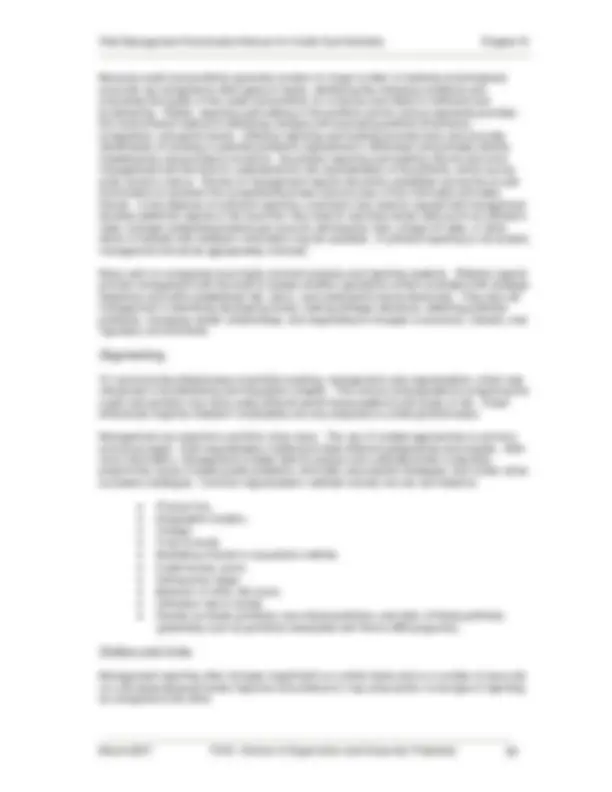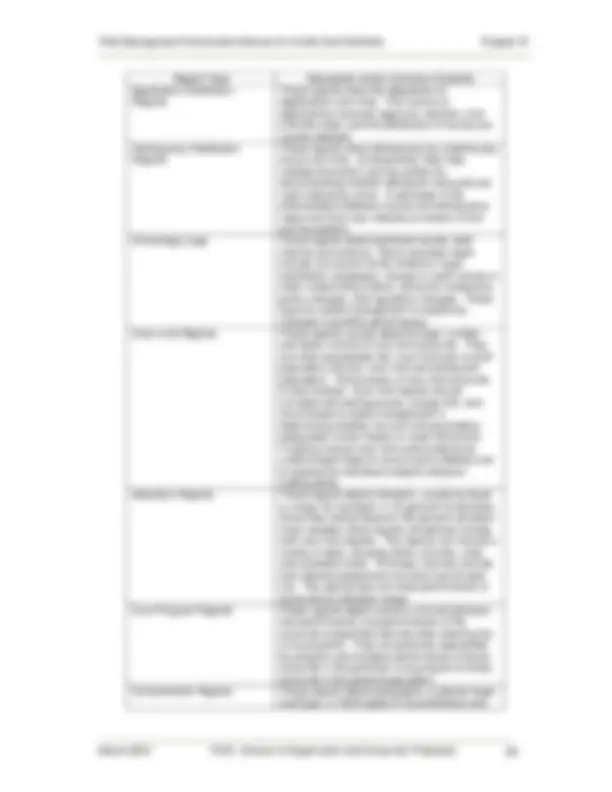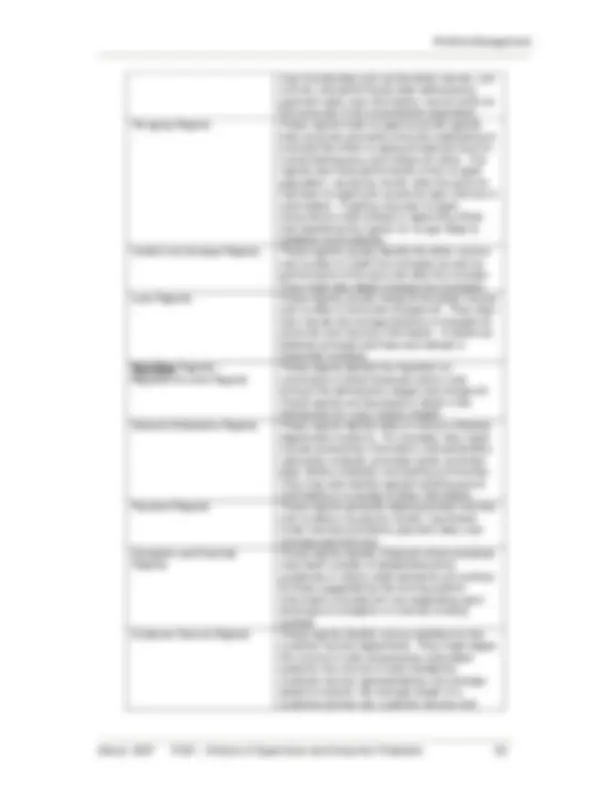
























Study with the several resources on Docsity

Earn points by helping other students or get them with a premium plan


Prepare for your exams
Study with the several resources on Docsity

Earn points to download
Earn points by helping other students or get them with a premium plan
Community
Ask the community for help and clear up your study doubts
Discover the best universities in your country according to Docsity users
Free resources
Download our free guides on studying techniques, anxiety management strategies, and thesis advice from Docsity tutors
Portfolio management covers the full spectrum of overseeing and administering the credit card programs, portfolios, and accounts.
Typology: Lecture notes
1 / 30

This page cannot be seen from the preview
Don't miss anything!























Risk Management Examination Manual for Credit Card Activities Chapter IX
Portfolio management covers the full spectrum of overseeing and administering the credit card programs, portfolios, and accounts. It encompasses risk management, account management, portfolio reporting and monitoring, and many other activities. Inappropriate portfolio management practices can create sizable risk for the bank, including credit risk, reputation risk, liquidity risk, and other risks. Portfolio management is challenging because the goal is to offer the customer efficient services and responses while internally controlling costs, appropriately managing risks and revenues, and achieving corporate and regulatory compliance.
Risk management is considered the broadest of the portfolio management terms and involves the overall monitoring and managing of the quality and risks of the credit card portfolio. It includes, but is not limited to, evaluating underwriting standards and modifying those standards as needed to maintain an acceptable risk level in the portfolio. Account management, portfolio reporting and monitoring, consumer complaints, fraud, and other functions are also essential subsets of risk management. In all, risk management should address research, development, testing, and product roll out, to monitoring on-going performance of the products, to post-mortem analysis.
Aspects of the risk management function, such as the level of technology as well as the degree of sophistication and number of staff needed, normally depend on the size and complexity of the credit card activities and of the bank itself. Independence from those who make day-to-day marketing, underwriting, and account management decisions provides an important control. Risk management is sometimes performed by a separate risk management department. In other cases, the board might assign it to other functional areas such as loan review and/or credit administration. Regardless of where responsibility is assigned, examiners should look for evidence that management has implemented sound practices that identify risk, establish controls, and provide monitoring. In general, risk management is involved in many functions, including:
Common tools used for risk management include data warehouses, portfolio management software, credit scoring, ACS, and risk models. Data warehousing capabilities allow the storage and retrieval of pertinent data. ACS are discussed in the Scoring and Modeling chapter, but to reiterate, are decision-tree strategies used to formulate account management approaches. They bring consumer behavior and other attributes into play.
Risk management’s purposes with regard to marketing and underwriting is to determine the characteristics of the responders and analyze the results of marketing programs to ascertain if
March 2007 FDIC- Division of Supervision and Consumer Protection (^66)
Portfolio Management
they were successful in attracting the targeted populations. As a result of this process, management can adjust underwriting standards to maintain an acceptable risk level in the card portfolio. Marketing and underwriting are discussed in the Marketing and Acquisition chapter as well as the Underwriting and Loan Approval Process chapter. The remainder of this chapter largely focuses on risk management’s role in the on-going servicing and monitoring of the card programs, portfolios, and accounts subsequent to marketing and underwriting. As such, account management and portfolio reporting and tracking are two key subjects of this chapter. Other risk management functions, such as loss allowances, are discussed in later chapters.
Examinations have disclosed a wide array of risk management, account management, and loss allowance practices, many of which have been inappropriate and have substantially elevated banks’ risk profiles. In response, the FDIC jointly issued the Account Management and Loss Allowance Guidance for Credit Card Lending (Account Management Guidance, or AMG) on January 8, 2003. The AMG is generally applicable to all FDIC-supervised institutions that offer credit card programs as well as to similar institutions supervised by other regulatory agencies. It generally applies regardless of where the receivables reside.
The AMG specifically speaks to credit line management, over-limit practices, minimum payments and negative amortization , workout and forbearance practices, and income and loss allowance practices. Regulatory scrutiny and risk management expectations for certain practices will be greater for higher-risk portfolios and portfolio segments, including those that are subprime. Less than full compliance with the AMG should generally be criticized. However, the Agencies do recognize that limited exceptions to the AMG may be warranted in well-managed programs. In those cases, examiners should expect that exceptions are addressed in the bank’s policies and procedures, the volume of accounts granted exceptions is small and well-controlled, and management is closely monitoring the performance of those accounts.
An assessment of the overall adequacy of account management practices factors in the bank’s risk profile, strength of internal controls, quality of management reporting, and adequacy of charge-off and loss allowance policies. The following sections of this chapter discuss key account management practices, including those addressed by the AMG. Subsequent sections discuss reporting and tracking associated with those functions.
Account management generally refers to any actions that the bank takes after a card account is originated and often in response to changes in cardholders’ financial capacities. The changes can be brought about in several ways and may be for the better or for the worse. Account management encompasses the continual evaluation of accounts to identify and respond quickly to the changes in borrowers’ financial conditions or behavioral patterns. The process is challenging because cardholders are not typically obligated to supply financial information after their accounts are opened.
Account management covers many activities and affects the amount and the length of time the bank makes credit available to the consumer. Adequately monitoring and managing account information necessitates effective strategies to handle the large volume of open-end credits and efficient information systems capable of generating reports needed to make on-going, timely credit decisions. Account management processes vary depending on the bank’s size, level of automation, and staff expertise. They also vary depending on an account’s status (for example, good standing versus a problem account) and on product type or cardholder attributes (for example, prime versus subprime accounts). But, no matter the program type or account status, regulators expect banks to have a means of identifying the current risk profile of portfolio(s).
March 2007 FDIC – Division of Supervision and Consumer Protection 67
Portfolio Management
Failure to understand the current risk profile of cardholder accounts could lead to an artificially low level of identified credit risk which could translate into under-funded allowances and stress on liquidity, earnings, and capital. Issuers normally obtain a current risk profile on cardholder accounts by re-scoring accounts. Often, this is referred to as refreshing the credit score. In the past management typically obtained refreshed credit scores semi-annually or annually. However, quarterly and monthly refreshes are now common. By refreshing an account’s credit score, management is able to identify apparent trends in the consumers’ financial situation in the absence of updated consumers’ financial information and potentially before any financial stress may be apparent based on the cardholder’s internal performance. Within the bank’s information systems and databases, both the original credit score and the refreshed credit score for each account are generally maintained to facilitate more effective risk management of the account and the portfolios. For example, the scores can be used in migration analysis.
More sophisticated institutions use behavior models in conjunction with credit scores. Similar to credit scores, behavior scores are refreshed on a regular basis. Due to expenses involved, smaller banks often do not use automated behavioral scoring systems. However, vendors continue to work to make these or similar systems more attainable for smaller institutions. Scoring models are discussed in the Scoring and Modeling chapter.
The amortization of principal balances is one of the key factors when determining whether a bank’s credit card lending practices are safe and sound. As such, setting appropriate minimum payment requirements is a critical function of management. The failure of minimum payments to sufficiently amortize the debt in a reasonable timeframe not only elevates credit quality concerns and consumer protection issues but can also understate the level of delinquent accounts. Such an understatement could affect decisions made by parties interested in the financial conditions of the portfolio and the bank, including investors in securitizations of the portfolio.
Competitive pressures combined with desires to sustain outstanding balances and/or customer performance had led many banks to ease minimum payment requirements over time. Such easing often delayed principal repayment, thereby increasing credit risk and masking portfolio quality. While initially attractive to many consumers, the low payments often ultimately caused those consumers to face repaying a growing balance. The liberal repayment requirements resulted in negative amortization, a phenomena in which the outstanding balance owed on the card builds even though no new charges are made. The rising balance occurs because minimum payments fall short of covering all finance charges and fees assessed. The hazards of negative amortization are magnified when subprime lending is involved.
Further, programmatic, recurring over-limit fees and other charges often exacerbate the situation. In general, these types of fees are considered inappropriate when they are primarily aimed at increasing recorded income rather than at serving as a tool to enhance the borrower’s performance or access to credit. Programmatic, recurring fees are typically defined as fees charged on an account as the result of the bank’s fee program. These types of fee programs become problematic if they result in a cardholder’s balance continuing to grow due to interest and fee assessments even if the cardholder meets subsequent minimum payment requirements. For example, if the bank has an over-limit fee program that assesses an over-limit fee every month an account is over-limit, even if the event that caused the over-limit occurred in prior billing cycles, yet the minimum payment does not require payment of the entire over-limit amount, the account balance would normally grow. Assume for this example that an account becomes over- limit by $100 and is assessed an over-limit fee of $30 at the end of the billing cycle. If the subsequent minimum payment required is not sufficient to cover the over-limit fee and the over-
March 2007 FDIC – Division of Supervision and Consumer Protection 69
Risk Management Examination Manual for Credit Card Activities Chapter IX
limit amount ($130) plus normal interest and fees, and the borrower only makes the minimum required payment (and thus, remains over-limit), the bank then assesses another $30 over-limit fee in the next billing cycle in accordance with its over-limit fee program. This type of program is clearly problematic since it results in continual fee assessments without requiring sufficient payment to cure the event that is resulting in the fee.
To address the liberalized minimum payment environment and the reality that minimum payments were not keeping pace with industry changes such as elevated line assignments; increasing and complex fees; and higher interest rates (risk-based pricing); the Agencies designed the AMG to specifically speak to minimum payments and negative amortization. The AMG calls for required payments to amortize the existing balance over a reasonable period of time, consistent with the unsecured, consumer-oriented nature of the debt and the borrower’s documented credit-worthiness. Safety and soundness concerns arise when prolonged negative amortization, inappropriate fees, and other practices inordinately compound or protract consumer debt or mask portfolio performance and quality. When proper minimum payment requirements are not evident, examiners are expected to voice criticism and ask management to take proper and timely action which could include augmenting allowances, revising the design of minimum payment requirements, and/or altering their courses of action for fee assessments, depending on the situation.
According to the AMG, minimum payments should cover all finance charges and fees assessed during the billing cycle. Within the industry, fees included in minimum due requirements continue to vary. With the innumerable fees and ever-changing fee terminology evident in the industry, developing guidance specifically naming fees that would be consistently interpreted uniformly as well as would be comprehensive for all portfolio types would be difficult, if not impracticable. Rather, regulators generally allow management to look at the particular structures of the bank’s products and set the minimum payment requirements for each product or segment in the context of those structures, as long as it amortizes the debt in a reasonable timeframe. A minimum payment method that is acceptable on one portfolio or segment might not be acceptable or reasonable for another portfolio or segment.
Because a uniform minimum payment structure has not been specified, minimum payment methods continue to vary. Some banks tier the total percentage due based on the outstanding balance. Several banks have designated an “equal to the greater of” approach where the balance due is the greater of a flat percentage of the outstanding balance, a flat dollar amount, or a certain percent of the balance plus interest charges and applicable fees.
Whatever minimum payment method(s) the bank uses, examiners should look for evidence that the method(s) provide for a reasonable amortization period. Interpretations of “reasonable amortization period” vary. Some banks require a one percent principal reduction per month in addition to payment of interest, late fees, and over-limit fees. Under that structure, a cardholder is generally required to demonstrate that he or she could amortize the debt in less than 10 years if he or she were to make the same dollar-level payments going forward. In reality, because the one percent principal reduction would be based on a declining principal balance (assuming no new charges are made), the amortization period is generally longer if, in subsequent months, the cardholder pays only the minimum due as requested by the bank. But, by making such payments, the cardholder proves that the ability to repay the debt in less than 10 years from that point exists. Minimum payment requirements that would not confirm a cardholder’s ability to amortize the debt in less than 10 years or that are so small as to draw into question whether the borrower has the proper financial capacity likely warrant close review to determine how and whether such a payment structure meets the spirit and intent of the AMG. This is not to say that amortization periods that are greater than 10 years cannot be acceptable or that amortization periods of 10 years or less are automatically acceptable. Rather, it reflects that longer-term structures, such as those greater than 10 years, have generally shown higher propensities to increase credit risk and mask portfolio quality, and, as such, are usually considered as a starting point for examination analysis.
March 2007 FDIC- Division of Supervision and Consumer Protection (^70)
Risk Management Examination Manual for Credit Card Activities Chapter IX
the inclusion of all fees (which would include late fees), or does not identify delinquent accounts as an exclusion to its guidelines. Regardless of whether or not payment is made and what the size of any payments made are, examiners should be concerned when the required minimum payment as prescribed by management is not designed to amortize the debt timely.
In addition to verifying whether proper minimum payment requirements have been established in policies and cardholder agreements, examiners should look for evidence that the bank’s systems factor in proper minimum dues. If processing systems are not set correctly and/or if minimum payments are billed incorrectly, the bank might be under-reporting past dues. While these comments are not specifically addressed to partial payments, partial payments could constitute one example of how systems could be set inappropriately. A discussion about partial payments is housed under the Delinquency section of this chapter.
Payment deferral programs allow cardholders to defer one or more minimum monthly payments and are also known as skip payment programs or payment holiday programs. Interest continues to accrue on the balance during the deferral period. Cardholders selected for a payment deferral program are usually notified by telephone, monthly statement inserts, or separate mailings. Normally these marketing efforts occur during high purchasing periods such as holidays or peak vacation periods. Some banks allow flexibility by offering the right to skip one or more minimum payments at any time during the year.
Before implementing payment deferral programs (or to continue offering payment deferral programs) management is expected to carefully weigh the customer base to determine whether these types of programs would be appropriate for the card program offered. Skip-payment programs generally should be only offered to the most credit-worthy customers, if offered at all. For example, subprime programs or small balance programs may be directed to individuals who have had trouble maintaining or who are trying to establish consistent, favorable payment performance. Payment deferral programs might not be appropriate in some of these cases.
Payment deferral programs interrupt the regular payment stream, diminish management’s ability to monitor performance and promptly identify problem accounts, and might be to some degree counterintuitive to the spirit and intent of the AMG, particularly if resulting in prolonged negative amortization. As such, some banks have discontinued these types of programs. However, for banks that still use such programs, evidence should substantiate whether management has established clearly defined policies and procedures for determining the credit criteria for account selection and for program parameters, such as how often a cardholder can qualify and for how many payments. Management may also consider the impact of these types of programs in any amortization analyses it conducts. Their failure to monitor the program’s success, regularly review accounts for performance, and periodically evaluate eligibility requirements is normally cause for concern as are deferred payment plans that are offered to cardholders who are anticipated to abuse the privilege and create safety and soundness problems.
Pre-payment programs, or pay-ahead programs , are similar to payment deferral programs in that they allow the cardholder to skip one or more minimum monthly payments. However, these programs are targeted to cardholders who make payments in excess of the minimum monthly payment and entail the application of excess payment amounts to the next consecutive payment(s). Pre-payment programs vary. Some allow cardholders a zero minimum payment requirement until the pre-payment amount is exhausted, while other programs have set time limits. For example, a bank might only allow a zero minimum monthly payment for one billing cycle, regardless of whether the excess paid surpasses one minimum monthly payment.
March 2007 FDIC- Division of Supervision and Consumer Protection (^72)
Portfolio Management
Pre-payment programs in and of themselves might not be problematic, but have the potential to be counterintuitive to the spirit of the AMG. Similar to payment deferrals, they interrupt the payment stream and diminish management’s ability to monitor performance and promptly identify problem accounts. Consideration of the impact of these types of programs in any amortization analyses the bank conducts may be helpful. Examiners should look for evidence that corroborates that before management implements pre-payment programs (or continues offering such programs) it carefully looks at the customer base to determine whether these types of programs are appropriate for the card program offered. Well-structured programs generally only offer the option to the most credit-worthy customers and are subject to clear guidelines, including identifying the maximum number of payments that can be skipped and monitoring the programs.
The AMG addresses credit line management, and in general, requires careful consideration of borrowers’ repayment capacities when establishing or modifying credit lines. It also expects banks to test, analyze, and document line-assignment and line-increase criteria prior to broad implementation. In the past, many banks inappropriately used line assignments and line increase strategies to maintain asset growth and/or to mask poor portfolio performance (for example, using line increases to “cure” over-limits).
Initial Credit Line Assignment:
Initial credit line assignments are discussed in the Marketing and Acquisition chapter as well as the Underwriting and Loan Approval Process chapter. In summary, concerns normally arise when the initial line assigned is not commensurate with the consumer’s willingness and ability to repay the credit under established, reasonable terms (which would include minimum payment and amortization configurations consistent with the AMG’s guidelines). Situations where support for the line assignment does not include documentation of relevant credit decision factors or where management has not ensured that the level of available credit and card utility offered is reasonable and well-disclosed warrant close inspection.
Credit Limit Increases:
Similar to multiple account strategies, liberal line increase programs can increase the risk profile of a borrower quickly and can result in rapid and significant portfolio deterioration. Concerns normally arise if the bank does not have the capacity to fund the increased lines if drawn or has not carefully considered the borrower’s repayment capacity, including any other accounts that the customer has with the bank. Most often, repayment capacity is determined with the use of scores and consideration of the borrower’s performance history rather than income verification. Some banks charge a fee for increasing the credit line. Risks of improper management of line increases are that earnings could be unduly overstated and/or that the bank could be taking on credit risk that it cannot handle. According to the AMG, management should be testing, analyzing, and documenting line increase criteria prior to broad implementation.
Credit limit increases are normally prompted with management-initiated, system-wide automated programs or through cardholder requests. Most management-initiated programs use scoring models, behavior models, or a combination of both, to screen the cardholder base and determine the pool of eligible accounts. The systemic programs also usually consider other qualifying criteria, such as the time elapsed since an account’s origination and/or since prior line increases, and usually incorporate champion/challenger strategies. With automated line increase programs, the increases are granted whether or not the customer needs or wants the increase. However, consumers may ask the bank to withhold their accounts from the automated strategies.
March 2007 FDIC – Division of Supervision and Consumer Protection 73
Portfolio Management
Multiple Credit Lines :
The Underwriting and Loan Approval Process chapter talks about multiple account strategies. Due to added management requirements, granting multiple credit cards with smaller lines generally results in as much or more risk than granting a consumer one card with a higher line. The AMG expects banks that offer multiple credit lines to have sufficient internal controls and systems to aggregate related exposures and effectively analyze performance.
Authorization is the process of verifying that the card account has sufficient credit available to cover the amount of the transaction. The transaction’s risk is assessed, and the process yields an approval, a decline, or a pending response in which the merchant must take additional steps, such as calling a toll-free authorization phone number. If the authorization is approved, the amount of the transaction is reserved on the card. In some cases, as with car rental companies and hotels, the exact amount of the transaction may not be known before the customer uses the product. In these situations, temporary holds are placed on the card accounts to provide merchants with a level of assurance that they will be paid for the services used.
The authorization process is structured to prevent transactions being approved for cardholders who have not satisfactorily maintained their account or who may be over-limit (and, hence, limits credit risk) and is also designed to protect against the unauthorized use of stolen or fraudulent cards. An effective authorization system allows good customers to make transactions within preset limits while preventing other transactions that pose undue risk to the bank. In most instances, banks automatically authorize transactions unless the transaction exceeds the authorized limit tolerance (either based on percentage or dollar amount), fraud is detected, or some other type of mismanagement is evident on the account. For example, a system might be set to authorize good customers to transact purchases up to five percent over their credit limit. If the purchase would put the cardholder at six percent over the credit limit, the authorization would be declined or might be referred for manual review. Authorization criteria beyond the normal credit limit, such as when a bank sets the system to allow certain cardholders to go a certain percentage above their credit limit, are sometimes referred to as expansion criteria.
Merchants process customer charges many ways, including but not necessarily limited to, a paper-based transaction , a dial-in terminal, or an electronic card reader. Clearing customer charges via paper sales drafts and dial-in terminals can be slow and costly. Speed and cost advantages prompt many merchants to use electronic card readers. The electronic networks enable virtually immediate authorization for most point-of-sale transactions. And, while most use electronic networks, the authorization process differs depending on merchant and transaction type. For example, for restaurants, an authorization might be obtained for the total check amount and a preset authorization tolerance. If the customer provides for a gratuity beyond what the preset authorization would cover, an additional authorization must be obtained. For card-not- present transactions (such as for mail or phone orders), other processes, such as address verification, are incorporated.
Authorization systems vary but commonly intend to provide reasonable assurance that charges are only authorized within prescribed credit limit tolerances and that accounts are appropriately blocked to prevent future authorizations when fraud is detected. Regardless of the authorization process used, examiners normally look for evidence that:
March 2007 FDIC – Division of Supervision and Consumer Protection 75
Risk Management Examination Manual for Credit Card Activities Chapter IX
General purpose credit cards have pre-set expiration dates, usually two to three years after issuance. Expiration dates have generally lengthened not only to help reduce expenses that accompany renewal but to help control fraud by limiting the volume of cards within the mail system. Although cardholder accounts are evaluated for creditworthiness periodically throughout the account relationship, the expiration date gives management the right not to renew (or reissue) the account relationship at that time (and, hence, the ability to control credit risk). In general, proper written credit and performance guidelines establish credit criteria, consider the length of the relationship, and include performance criteria such as average outstanding balance, usage rate, payment and delinquency patterns, and account profitability. Normally, the renewal process is automated, uses scoring and behavior models, and is applied to the entire portfolio. Examiners should analyze management’s practices for periodic testing of the integrity of the system and evaluating the effectiveness of renewal strategies.
Customer service encompasses a wide variety of activities, including, but not limited to, activating cards, initiating balance transfers, and handling account inquiries. Customer service can be conducted through written correspondence but is more often conducted via phone and increasingly online.
Consumer Complaints and Litigation:
The customer service area might identify consumer complaints. Complaints can serve as an early warning signal for compliance, credit, and operational issues, including discriminatory, unfair, deceptive, abusive, and predatory practices. Concern is normally warranted when banks are not prepared to handle consumer complaints promptly, including maintaining well-defined procedures. Recognition of bank staff responsible for handling the complaints that is broadcast to all bank staff can help expedite referrals.
Failure to be sensitive to complaints can ultimately result in litigation (and hence, potential financial and reputation implications) or eventually result in legislation that is broader, more rigid, and more restrictive than was the particular practice that brought the complaint. Even if legal at the time, a bank’s policies and practices may prompt objections that lead to new regulations.
As mentioned in the Identifying Involvement in Credit Card Activities chapter, the FDIC’s Consumer Response Center is a source available to examiners to help identify the volume and types of complaints that consumers are bringing against the bank. Evidence gathered during the examination should help form an assessment as to whether or not management closely monitors complaint activity. Such evidence often involves complaint and litigation logs. The bank most likely only hears from a small proportion of its dissatisfied customers. Consequently, the impact of the potential problem may be much more far-reaching than a simple review of the volume of complaints might suggest. The type of complaint, therefore, is also very important to consider when assessing the level of risk.
Closures and Retention:
Many account closures occur voluntarily (the customer requests to close the account). Retention programs are critical to relationship management and in controlling attrition. With the credit card market remaining highly competitive, banks generally try to retain accounts when possible and when it would benefit the bank. If retention programs are not properly structured, adverse retention could occur. Monitoring the performance of retained accounts helps management detect adverse retention and determine whether retention practices are appropriate and effective.
March 2007 FDIC- Division of Supervision and Consumer Protection (^76)
Risk Management Examination Manual for Credit Card Activities Chapter IX
Collection strategies are not static and are not uniform across all banks. The growing size and complexity of the credit card business, along with the labor-intensive nature of collections, makes the collections function increasingly difficult to manage. Specialized, state-of-the art technology such as complex automated dialing systems and intricate skip tracing tools is frequently used to optimize productivity and control overhead costs. The collections area also frequently uses champion/challenger strategies.
Collection strategies generally attempt to direct efforts to those accounts with the greatest risk of loss and the greatest potential for collection. Ineffective strategies could result in reduced collections (and, thus, reduced earnings and liquidity). Some banks use scoring models to help predict the likelihood of collection and then employ collection practices such as phone calls, collection letters, legal letters, statement messaging, or enrollment in repayment programs, depending on the severity of the delinquency and what the score indicates. Successful subprime lenders have historically employed heightened collection efforts, such as calling delinquent borrowers more frequently, investing in highly-complex technology, and assigning more experienced collection personnel to seriously delinquent accounts. Collections for subprime lending is very labor intensive but critical to the program’s success.
Fee waivers are sometimes used as a collection tool. Collections personnel attempt to entice consumers to pay by surrendering or reversing certain fees. Often, the customer might be persuaded to pay more when fees are waived. Fee waivers are normally governed by policies that give clear guidelines as to acceptable limits on the level of fees waived (by dollar and/or percentage) as well as the types of fees that can be waived. The level of fees forfeited may be tied to collectors’ compensation packages (with fee waivers reducing compensation to some degree). In this respect, collectors using fee waivers as a tool are not inclined to abuse such practices, where the abuse could substantially impact the institution’s earnings (both due to fees lost and to potentially excessive compensation paid). Along the same lines, collection departments may focus on promises kept measurements as compared to promises to pay measurements when establishing incentive pay programs because a wide disparity sometimes exists between the volume of payments or dollars actually received from cardholders compared to the volume promised by cardholders.
Collection activities encompass, but may not be limited to, over-limit accounts, delinquent accounts, charge-offs and recoveries, re-pricing, re-aging and various cure programs such as workout programs. The following sections discuss each of these areas.
When an account is over-limit, it means that the account’s balance has surpassed the account’s credit limit, due to purchases or other assessments, such as fees. Over-limit authorization requests occur either by the cardholder contacting the bank or more frequently by the cardholder attempting to make a charge through the payment network. Customer-initiated requests can be routed to a credit analyst where, based on the credit analyst’s lending authority and the account’s history, credit score, or other criteria, the transaction is approved or denied. In many cases, over- limit approvals for purchases are automated rather than manually reviewed. Advanced systems use behavior scores, adaptive controls, and management’s parameters to approve or deny over- limits without human involvement. In addition, a combination approach is sometimes used. Authorizations up to a pre-set dollar amount or percentage above the credit line (expansion criteria or buffers) might be handled by automated systems, and transactions falling outside the expansion criteria would be referred for manual review or in some cases, automatically declined. Even with reasonable authorization parameters set, certain instances can occur in which authorization is granted above the credit limit or even beyond established expansion criteria. For example, “variable amount” and “under the floor limit ” charges can result in charges above an account’s established credit limit or above the expansion criteria.
March 2007 FDIC- Division of Supervision and Consumer Protection (^78)
Portfolio Management
A bank’s authorization practices could be a contributing factor in causing over-limits. Failure to establish proper guidelines for when and under what conditions over-limits will be granted could result in increased credit risk. Over-limit authorizations on open-end accounts, particularly those that are subprime, should be restricted and subject to appropriate policies and controls.
Examiners should direct their attention to practices whereby line increases are used to mask over-limit statuses. Further, without proper controls for handling payments returned for insufficient funds and for handling large-payment holds, these items can prematurely create available credit because only later (when the insufficient funds payment is returned) would the payment credit be reversed. In the mean time, the cardholder would have the opportunity to use the inflated available credit for purchases. Then, after reversal of the payment application, the cardholder could easily be over-limit to a degree which normally would not have been approved.
Prudent over-limit practices are important for all credit card accounts, including both prime and subprime accounts. When a bank’s fee assessment practices are designed to compound fees and other charges in order to trap its customers in a cycle of pyramiding over-limit debt, supervisory attention is warranted. Cases where cardholders go over-limit as a result of fees being assessed on their accounts have the potential of happening more often when the credit limits are small, such as with subprime accounts. In these cases, the account holders might go over-limit shortly after opening the account, especially when a small credit line is largely consumed by upfront fees leaving limited utility at account inception. When credit lines are small, the assessed over-limit fee(s) usually result in the over-limit balance being very high in proportion to the established credit line. No matter what size the credit lines are, fees are usually contributing factors to the level of over-limit balances.
Some banks notify customers ahead of time of upcoming fee assessments, such as annual fees, such that the cardholder would have time to remit payment(s) to free up available credit to cover the upcoming assessment. Once an account is over-limit, some banks take steps to reduce the impact of fee assessments. For example, some banks do not allow a late fee to trigger an over- limit fee if the late fee is what makes the account over-limit. Other banks cap the number of over- limit and/or other fees that can be assessed or suspend over-limit and other fee assessments in certain cases, such as when an account reaches a certain past-due status. The waiving or capping of fees is intended to help control the level of the over-limit amount and, thus, hopefully help and motivate the customer to pay off the over-limit balance in a timely manner as well as retain a reasonable amortization timeframe.
The AMG points out that practices that do not provide for timely repayment of over-limit amounts can significantly increase the credit-risk profile of the portfolio, and the increase is often magnified for subprime portfolios. It also notes that deficient reporting and loss allowance methods as a result of imprudent over-limit practices can understate credit risk. All banks are to carefully manage over-limit practices and focus on reasonable control and timely repayment of amounts that exceed established credit limits. In accordance with the AMG, examiners should look for proof that management’s objective is to ensure that the borrower remains within prudent established credit limits that increase the likelihood of responsible credit management. The Home Equity Lending: Credit Risk Management Guidance , which would be applicable to home equity credit card lenders, declares a similar position to that of the AMG.
The regulatory guidelines are written broadly to allow banks flexibility. Clearly fee structures, products, authorization strategies, and portfolio dynamics differ among banks, and absolute, un- flexible guidance would most likely not be reasonable or effective for all portfolios.
Examiners should assess management’s practices for ensuring over-limit accounts are repaid in a timely manner. Those practices generally include formalized (or defined) repayment programs that require cardholders to repay over-limit balances in a structured fashion. When an account goes over-limit, management might initially utilize techniques such as calling strategies and letter campaigns to attempt to get the cardholder to bring the account back within its established credit
March 2007 FDIC – Division of Supervision and Consumer Protection 79
Portfolio Management
The two categories can represent very different types of risk, but the risks of these accounts are not mutually exclusive. In the case of no-use, no-pay accounts, the consumer could be suggesting (by not remitting payment) that they did not understand the fees being assessed to the card upfront or that they no longer want the card (possibly due to its fees). Either of those scenarios might suggest compliance and/or reputation risk. Or, financial stress may be preventing the cardholder from making the first payment due. With no-use, no-pay accounts, the bank generally has not lost cash because no payment has been made to merchants. Rather, if the account never pays, the bank would have lost costs incurred in originating the account. However, in the case of use, no-pay accounts, the bank has remitted payment to merchants for the purchases, and if the cardholder does not pay, the bank will not recover the amount given to the merchant (unless the transaction is subject to charge-back). Use, no-pay accounts might be an indication of fraudulent activity. Or the lack of payment may be due to financial stress. If that is the case, it may suggest flawed underwriting criteria, particularly if the volume is substantial. Subprime portfolios usually reflect higher rates of first-payment default than do prime portfolios.
Collection strategies for delinquent accounts vary, often depending on whether delinquency is considered early stage or late stage and on the type of account. Typically, accounts in earlier delinquency stages require less collection effort than those in later stages. Early-stage collection efforts often include statement messaging and letters to the cardholder. Later-stage collection efforts usually consist of frequent calls to the cardholder and may also encompass enrollment in defined repayment programs that are discussed later in this chapter. Accounts that are both over-limit and delinquent generally require strong collection efforts as do subprime accounts.
The examiner’s evaluation of past due loans may incorporate the Lagged Delinquency Ratio which is the ratio of credit card loans that are past due 30 days or more plus those credit card loans on non-accrual measured against total outstanding credit card loans on a three quarter lag (total outstanding loans approximately 270 days, or three quarters, prior to the current period). It is particularly helpful when a bank has experienced rapid growth. A large volume of new loans being booked can mask credit problems by artificially lowering the current delinquency ratio as new loans (which would not yet be delinquent) are added to the denominator. A relatively high ratio can be an early warning sign of weak underwriting standards and potential future delinquency problems as the loans season.
The accuracy and integrity of the bank’s system for reporting past due credit card loans is critical to the proper and timely identification of credit risk. The examiner’s evaluation of past dues and the associated credit risk considers the bank’s partial payment, non-accrual, and re-aging practices, as well as the volume and trends of delinquencies. It also considers whether minimum payments are sufficient to reasonably amortize the debt.
Partial Payments:
The Uniform Retail Credit Classification and Account Management Policy (Retail Classification Policy) and Call Report instructions address partial payments. A payment equivalent to 90 percent or more of the contractual payment due may be considered a full payment in computing past due status. Alternatively, the bank may aggregate payments and give credit for any partial payment received. For example, if the payment due is $40 per month and the borrower makes payments of $20 per month for a six-month period, then the loan would be $120 ($20 shortfall times six months), or three full months, past due. A bank can use either or both of the methods in its portfolio but may not use both methods simultaneously with one loan. Improper partial payment practices could mask delinquencies and losses.
March 2007 FDIC – Division of Supervision and Consumer Protection 81
Risk Management Examination Manual for Credit Card Activities Chapter IX
Regulatory guidelines do not require consumer loans (including credit card loans) to be placed on non-accrual status when principal and interest remain unpaid for 90 days (nor do they require a similar loan secured by a 1-4 family residential property, such as a home equity credit card, to be put on non-accrual status). However, these loans are subject to alternative methods of evaluation to assure that the bank’s net income is not materially overstated. Management’s non- accrual practices are evaluated on a case-by-case basis.
Proactive non-accrual policies provide a more accurate and timely reflection of actual operating performance. Examples of proactive policies include placing accounts on non-accrual status when the account becomes 90 days past due, when the cardholder enrolls in a Consumer Credit Counseling Services (CCCS) program or workout program, or when the borrower threatens to file for bankruptcy protection. These types of policies can be encouraged; but, the lack of them is not necessarily grounds for criticism. Some credit card servicing platforms do not have the capability to place individual loans on non-accrual. To the extent that a bank elects to carry loans as non-accrual on its books, the bank must also report those loans as non-accrual on its Call Report. Furthermore, when one of a borrower’s loans is assigned to non-accrual status, any other loans outstanding to that borrower should be evaluated to determine whether one or more of them should also be assigned to non-accrual status. Lastly, state statues, regulations, or rules that impose more stringent standards for non-accrual of interest take precedence.
Re-aging :
Re-aging is technically defined as returning a delinquent, open-end account to current status without collecting the total amount of principal, interest, and fees that is contractually due. It generally refers to the removal of a delinquent account from normal collection activity after the borrower has demonstrated over a specified period of time and through some degree of performance that he or she is capable of fulfilling contractual obligations without the intervention of the collection department. It is viewed as one method of helping borrowers overcome temporary financial difficulties, such as job loss, medical emergency, or change in family circumstances, and is meant to be used for borrowers who have the capacity to satisfactorily service their debt, but are unable to catch-up on prior delinquency. Re-aging is often referred to as curing or rolling-back an account and is intended to prevent the account from remaining perpetually delinquent. A few banks continue to re-age on an exception basis, and some banks re-age manually. However, most banks re-age as a regular practice and use automated systems to complete the re-ages. While re-aging practices are usually reviewed during the examination, cases where re-agings total a sizable percentage of accounts (such as more than five percent) or have unexplained spikes should be even more carefully looked into.
Overly lenient practices can cloud the true performance and delinquency status of accounts and, potentially, of the card portfolio as a whole. Improperly managed re-aging practices can result in understated charge-offs and can impede accurate analysis of loss allowances. As such, establishing clearly defined policy guidelines and parameters for re-aging is critical, as are ensuring the reasonableness of those guidelines and monitoring their effectiveness. Other important practices for management include monitoring both the number and dollar amount of re- aged accounts, collecting and analyzing data to assess the performance of re-aged accounts, and determining the impact of re-aging practices on past due ratios.
The Retail Classification Policy governs re-aging. According to its provisions, an open-end account can be considered for re-aging if:
March 2007 FDIC- Division of Supervision and Consumer Protection (^82)
Risk Management Examination Manual for Credit Card Activities Chapter IX
Re-pricing is the process by which finance charges and/or fees (most often finance charges) are adjusted to reflect perceived changes in the risk-profile of the account. Re-pricing initiatives can include bureau-based, performance-based, or other initiatives. Re-pricing is often used to adjust pricing upward as a collection strategy and is frequently referred to as penalty pricing. Penalty pricing generally is used to offset collection costs (as compared to other fees which may be primarily intended to help the institution invest in technology, expand Automated Teller Machine (ATM) networks, or address other initiatives).
Bureau-based re-pricing refers to finance charge changes made to accounts based on changes in borrower credit-worthiness identified through shifts in credit bureau scores or other credit bureau information. As such, it is tied to the customer’s performance with all creditors. While the technique can be used to adjust the pricing down or up, it is most often used to increase pricing.
Performance-based re-pricing refers to finance charge changes made in response to borrower performance on the account with the issuing creditor. The strategy typically relies on internal behavior scores and delinquency patterns, but may also incorporate a number of factors including line utilization and bureau score. Like bureau-based analysis, performance-based analysis can be used to increase or decrease charges, but is most frequently associated with default price increases. When employed for delinquent accounts, there is often a provision to return to a lower finance charge following a specified period of sustained on-time payments.
Increasingly, banks are running periodic analysis of their portfolios and changing the terms of individual loans based on the results. For example, some banks have determined that certain yields have not been sufficient to offset risk, so they have implemented aggressive up-pricing campaigns. Universal default provisions have also become popular and subject consumers to upward pricing for various reasons. For example, a declining credit score can cause default pricing to kick-in. In addition, paying other credit obligations late or one of many other factors can also cause default-pricing to kick in. In some cases, these re-pricing practices may drive away good customers, leading to a concentration of higher-risk accounts. Examiners should determine if re-pricing initiatives received thorough and controlled testing before full implementation and how the re-pricing initiatives impact the portfolio and the bank’s performance.
Not all re-pricing occurs as a result of adverse trends in the consumers’ profile. For example, some institutions offer graduation programs that reward sustained successful performance of higher-risk borrowers by moving them from a subprime-type account (typically a low credit limit with a high price) to a more traditional or mainstream product that would have a lower interest rate, lower overall fees, and/or a higher credit limit.
Examiners should assess management’s internal controls and on-going monitoring of re-pricing initiatives. Provisions of re-pricing policies and procedures generally include:
Examiners may encounter accounts that are subject to the Soldiers’ and Sailors’ Civil Relief Act of 1940 (SSCRA). The SSCRA addresses service members’ credit obligations that were incurred prior to active military duty and that service members are unable to meet due either to their absence from home or from the financial consequences of significantly lower military pay in comparison to pay received for their normal (civilian) employment. The SSCRA does not apply to
March 2007 FDIC- Division of Supervision and Consumer Protection (^84)
Portfolio Management
any obligation entered into by a borrower after their military service has commenced. Some key provisions of the SSCRA include:
The SSCRA is discussed in FIL-134-2002. Management normally consults with legal counsel about the SSCRA and with its external accountants about applying the provisions of the SSCRA.
Banks have instituted various repayment plans such as workout plans, temporary hardship programs, and Consumer Credit Counseling Services (CCCS) programs. The object of these programs is to collect the amount due and improve the borrower’s subsequent performance. Banks are encouraged to work with borrowers on a case-by-case basis keeping in mind that use of these types of repayment programs to defer losses or to mask poor initial credit risk selection practices is improper.
Workout Programs:
A former open-end credit card account upon which credit availability is closed and the balance owed is placed on a fixed (dollar or percentage) repayment schedule in accordance with modified, concessionary terms and conditions is considered a workout credit. Generally, the repayment terms require amortization of the balance owed over a defined period. These arrangements are typically used when a customer is either unwilling or unable to repay the account in accordance with its original terms but shows the willingness and ability to repay the account in accordance with modified terms and conditions. Workout programs are generally directed at cardholders with longer-term moderate to severe credit problems. Temporary hardship programs which are intended to help borrowers overcome short-term financial difficulties are not considered workout programs unless the program’s duration is longer than 12 months (including renewals).
Characteristics of improperly managed workout programs include liberal repayment terms with extended amortizations, high charge-off rates (although loss rates on workout programs are normally higher than loss rates on the remainder of the credit card portfolio because of the cardholders’ weakened financial conditions), moving accounts from one workout program to another, multiple re-agings, and poor reporting of program performance. Repayment terms for workout accounts vary widely and sometimes have not included sufficient reduction of interest rates to facilitate timely repayment and assist borrowers in extinguishing the debt. In some cases, reduced minimum payment requirements coupled with the continued assessment of fees and interest extended repayment well beyond reasonable timeframes.
To address these problems, the AMG set workout program parameters. Per the AMG, the design of workout programs should maximize principal reduction and generally strive to have borrowers repay debt within 60 months. To meet these guidelines, banks might have to substantially reduce or eliminate interest rates and fees such that more of the payment is applied to reducing the principal. In addition to clearly documenting any exceptions to the AMG’s
March 2007 FDIC – Division of Supervision and Consumer Protection 85